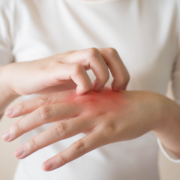Mirror Pain: What You Need to Know.
What is mirror pain?
Maybe you had been in pain for a while because of a broken arm or leg. Then one day, the opposite limb started hurting — even though it wasn’t injured.
That’s mirror pain.
Mirror pain happens in the exact same body part or body area on the opposite side of a trauma-affected or diseased body part.
And it can strike anywhere in the body — even in healthy teeth on the other side of diseased, painful teeth. Fortunately, mirror pain is usually not as bad as the injured side.
When does mirror pain strike?
Mirror pain symptoms usually begin after the nerve pain has turned chronic, typically three or more months after the original injury.
Chronic neuropathic pain can lead to nerve sensitization or increased sensitivity and spread the pain around the body.
In general, the greater the pain and inflammation in the injured area, the more likely the uninjured side will develop mirror pain.
How does mirror pain work?
You aren’t imagining it.
When you suffer an injury, your body’s immune response kicks on, and it starts attending to the injured limb or area.
That’s part of the healing process, and that’s good.
But sometimes, long after an injury, the body’s immune response affects the opposite, non-injured area. And that can cause nerve damage and pain.
Why does your body do this?
Though it may seem like the opposite of helpful, mirror pain may be the body’s way of sending you the message that you need to stay out of harm’s way for a while.
It may be trying to communicate something like, “Double the pain, double the caution.”
Is mirror pain treatable?
Like other nerve pain, mirror pain is treatable — but it’s also preventable. Indeed, nerve pain resulting from injury does not have to evolve into chronic nerve pain and spread to otherwise healthy limbs.
When treating patients with acute nerve pain from trauma or disease, doctors and pain specialists need to devise the most effective pain management plan and apply it early and aggressively.
But even if you already have mirror pain, there’s no reason to worry because it’s very treatable.
Pain specialists can effectively manage and treat it using medicines, therapies, and non-invasive techniques like electrical nerve stimulation.
Pain Treatment You Can Trust
Do you have mirror pain or think you may have it? Our pain management specialists can devise a pain treatment plan that works for you.
To find out how our multidisciplinary, interventional pain management treatment options can change your life, please give us a call or book an appointment online.
5 Ways to Help You Describe Your Pain to Your Doctor
It can be hard to give your doctor an accurate depiction of your pain issue.
But it’s necessary to get the treatment you need.
So, we created this list of five ways you can better describe your pain to your doctor to help prepare for your next visit.
1. Be ready to describe how severe it is.
At your visit, doctors and nurses typically ask you:
- How bad your pain is on a scale of one to ten.
- Whether your pain is mild, moderate, or severe.
- To choose from several or more faces with expressions showing varying degrees of pain.
Coming to your appointment prepared with answers to these questions will give your doctor a clearer picture of your pain issue.
2. Keep a detailed record of your pain.
A “pain journal” is a great way to gather and organize your thoughts into a detailed, accurate pain record.
Here are some questions to consider:
- When did it start? Is it constant, or does it come and go?
- If it comes and goes, what time of day do you feel it? In the night, morning, afternoon, evening, or more than one?
- Does any action like sitting down, laying down, or standing up make the pain better or worse? Does applying cold or heat to the affected area relieve or worsen it?
- Is there any discomfort along with the pain, such as numbness, coldness, or warmth?
3. Choose a few words that accurately describe how it feels.
Ask yourself whether the pain is dull, sharp, throbbing, radiating, or something else. Here are some words for inspiration:
- Aching, burning, cramping, grating, lingering, penetrating, piercing, radiating, searing, scraping, shooting, splitting, stabbing, stinging, tearing, throbbing, tingling, tugging, wrenching, sharp, tender, tight, dull
4. Be prepared to talk about any previous pain treatments.
- Have you tried acupuncture, chiropractic, or any other natural treatments or therapies?
5. Write down everything your pain keeps you from doing.
List all the things you would do in your daily life if pain-free or in less pain. Can you lift objects and twist, turn, and bend freely? Can you climb stairs and stand for extended periods?
Pain Management and Treatment with Kindness
The pain specialist team at Texas Pain Physicians provides friendly, compassionate care — from your first consultation to your last treatment.
If you’re in pain, please visit one of our locations in Dallas, Houston, Irving, or elsewhere in Texas. Give us a call today to schedule your appointment or book online.
7 Non-Invasive Treatments for Hip Pain
Healthy hips let you twist and turn freely.
But hip injuries, failed hip surgery, and disease and degeneration from aging can keep you from doing all the working, playing, helping, and participating that your life demands.
Non-surgical treatment is the best way to address the pain and restore function.
Here are seven non-invasive or non-surgical treatments for hip pain.
1. Steroid Injections
Pain can stop you in your tracks, and when it does, steroid injections directly into the hip can give you immediate pain relief.
Steroid injections contain two main ingredients: a corticosteroid to reduce inflammation and a numbing agent or anesthetic to numb the pain.
2. Platelet-Rich Plasma Infusions
Taking platelets from your blood and infusing them into your hip area can heal wounds and repair cartilage for hip problems caused by injury.
There’s no scientific evidence, however, that this therapy is effective for pain due to arthritis.
3. Nerve Block
Nerve blocks can provide short-term relief for chronic hip pain due to injury or hip surgery (including hip replacement surgery).
The procedure involves injecting an inflammation-reducing steroid straight into the femoral-obturator nerves to stop them from sending pain signals.
4. Radiofrequency Ablation
Once nerve blocks successfully provide short-term hip pain relief, radiofrequency ablation becomes a viable option for long-term pain relief.
The procedure involves heating and inserting a specially-designed needle into the femoral and obturator nerves running into the hip joints. The needle’s heat can stop these nerves from sending pain signals for more than six months.
5. Trigger-Point Injections
In the hips and other areas, painful muscle knots known as “trigger points” can form when muscles are tense for too long. Often, you can feel these knots under the skin.
These trigger points can irritate the nerves around them and cause you even more pain.
A trigger point injection involves injecting an anesthetic, saline, or corticosteroid straight into the trigger point. One procedure can bring long-term relief.
6. Physical and Occupational Therapy
Regardless of what’s causing it, physical therapy can reduce pain over time by increasing flexibility and strengthening muscles and soft tissue.
And when it comes to reducing pain caused by daily life’s demands, occupational therapy can help. Learning healthy sitting and standing posture and sound techniques for movements like lifting objects and sitting up in bed can help minimize or eliminate pain.
7. Over-the-Counter (OTC) Pain Medications
OTC pain relievers such as acetaminophen (Tylenol) and ibuprofen (Advil) can relieve hip pain and reduce inflammation.
Treatment for Hip Pain at Texas Pain Physicians
If you have hip pain, please give us a call today. We can explain more about any of these treatments and find out the best option for your specific health situation.
If you would like to book a visit with us online, please click here.
10 Treatments for Complex Regional Pain Syndrome
Breaking or spraining a limb or having surgery hurts. That’s normal.
But burning pain, warm, sensitive, and swollen skin, and restricted mobility in your hands and feet long after an injury or surgery aren’t.
These symptoms could mean complex regional pain syndrome (CRPS) — a chronic pain disorder.
Yes, some doctors say it’s just a made-up condition for drug seekers.
And they’re wrong. It’s a real disorder. Here are some minimally-invasive treatments:
1. Nerve Block Injections
Research suggests that injury to or abnormality with the peripheral or central nervous system may cause complex regional pain syndrome.
Nerve block injections can give you quick, extended pain relief by blocking errant nerve signals.
The two types of nerve block procedures for CRPS are stellate ganglion blocks and sympathetic nerve blocks.
2. Transcutaneous Electrical Nerve Stimulation (TENS)
Transcutaneous Electrical Nerve Stimulation therapy can relieve chronic pain conditions like CRPS by applying electrical impulses to nerve endings.
3. Spinal Cord Stimulation
This minimally invasive procedure involves inserting tiny electrodes along your spinal cord, which deliver electrical current that can relieve chronic pain.
4. Physical Therapy
For many people affected by CRPS, one of the keys to a better quality of life is improved or fully restored limb function.
Physical therapy can do this by increasing blood flow, strength, and flexibility in the injured limb.
5. Desensitization
One of the symptoms of CRPS is increased or extreme skin sensitivity. Even gentle contact with the affected limb or area can be painful.
Desensitization therapy can decrease the sensitivity over time by introducing affected areas to various sensations, including varying textures, weights, and temperatures.
6. Oral and Intravenous Medication
There aren’t any CRPS-specific medications, but the following medicines can help with the pain:
- over-the-counter pain medications (Non-steroidal anti-inflammatory drugs like ibuprofen and aspirin)
- Antidepressants and anticonvulsants
- corticosteroids
- dextromethorphan
- intravenous ketamine
7. Topical Pain Medication
Over-the-counter creams and patches, such as lidocaine and capsaicin, can reduce skin hypersensitivity.
8. Occupational Therapy
CRPS can be a debilitating condition that stops you from performing everyday activities and maintaining your school, work, family, and social life.
Occupational therapists can teach and equip you with methods and assistive devices that help you adapt so you don’t have to put your life on hold.
9. Mirror Therapy
With “magical” mirror therapy, you first position yourself next to a mirror.
Next, you hide your CRPS-affected limb, allowing the mirror image of your healthy limb to “take its place.”
Finally, move your healthy limb around and watch it move in the mirror.
The goal is to train your brain to perceive your healthy limb as your CRPS-afflicted limb. Research suggests this might increase flexibility and function and reduce pain.
10. Psychotherapy
How you think can have a massive impact on you physically.
Mental illnesses such as PTSD, major depressive disorder, and social anxiety disorder can make you focus and even obsess about pain symptoms.
That’s why getting your mental illness treated can give your CRPS treatment an added boost.
World-Class Treatment for Complex Regional Pain Syndrome
At Texas Pain Physicians, our mission is to provide comprehensive pain care to our patients.
Our board-certified pain physicians work in the most advanced pain care facilities and have the expertise and cutting-edge technology to improve your quality of life and functionality.
Please give us a call or book your appointment online today!
Do I Have Tendonitis or Tendinosis?
You’ve probably had or at least heard of the tendon problem known as tennis elbow. And chances are you’ve heard people say that it’s a form of tendonitis.
You may not have heard of the other type of tendon problem called tendinosis.
Its symptoms are often mistaken for tendonitis, and therefore, it’s often treated like tendonitis.
Let’s zoom in on five common misunderstandings to see if we can clear up the confusion.
1. Tendonitis is a chronic pain condition. (Wrong!)
Tendonitis is acute or sudden onset, short-term pain from inflammation due to a direct injury.
The symptoms of tendonitis, which are due to inflammation, include swelling, redness, and warmth.
By contrast, tendinosis or tendinopathy is chronic or consistent and recurring pain due to degeneration. Repetitive trauma or injuries causes degeneration characterized by microscopic tears in the tendon.
Tendinosis symptoms include pain but no swelling, redness, or warmth.
2. Rest is always the best treatment for tendon pain. (Wrong!)
Resting or keeping weight off the tendon doesn’t cure tendinosis because the pain is due to degeneration rather than inflammation.
The initial pain and swelling of tendinosis are similar to inflammation, but the underlying cause is chronic degeneration due to aging, repetitive use, or repeated injury.
Tendonitis, however, is characterized by inflammation. Therefore, resting or keeping weight off of the tendon does help bring healing and pain relief.
3. Anti-inflammatory medication, steroid injections, and cold therapy are always effective treatments for tendon pain. (Wrong!)
These are effective treatments for pain from inflammation, so they are effective in treating tendonitis.
For tendinosis, anti-inflammatory medication, steroid injections, and cold therapy can relieve pain in the short run but can’t heal the degenerative damage.
What will provide healing and pain relief is physical therapy that stretches the injured tendon and surrounding muscles.
4. Tennis elbow is always tendonitis. (Wrong!)
The truth is, tennis elbow can be either tendinosis or tendonitis. Tennis elbow affects the tendons that connect the forearm muscle to the outside of the elbow.
Treatment will depend on the type of tendon pain.
5. Plantar fasciitis is a form of tendonitis. (Wrong!)
Plantar fasciitis is tendinosis in the plantar fascia, the long, thin ligament on the bottom of the foot. Over time, micro-tears develop in the plantar fascia, which causes pain.
Tendonitis and tendinosis treatment in Houston and Dallas
At Texas Pain Physicians, our pain management specialists know how to diagnose and treat tendon pain. Please don’t make the mistake of guessing what’s causing your pain then applying the wrong treatment.
To make your appointment, give us a call or book online today!
5 Popular Fibromyalgia Myths Debunked
Fibromyalgia is often mistaken for other chronic pain conditions, disorders, and diseases.
There’s widespread misinformation about this disease, which has created a lot of confusion.
Let’s dig into it and separate five common fibromyalgia facts from fiction.
1. Fibromyalgia isn’t real. (Wrong!!!)
Many doctors tell patients with fibromyalgia symptoms that the disease doesn’t exist. Then a rheumatologist or pain specialist diagnoses them with fibromyalgia. What’s going on here?
It’s simple. Everyone has blood pressure and blood sugar and experiences physical and emotional pain to some degree.
Doctors diagnose diabetes and hypertension (high blood pressure) when blood sugar and blood pressure are above the normal range on a sliding scale.
And that’s how they diagnose fibromyalgia, with pain being the variable that goes beyond the normal range instead of blood pressure or blood sugar.
Now, pain and fatigue from exercise, injuries, and lack of sleep comes and goes. It’s normal. But steady pain in several or more body parts for three months or longer isn’t, and fibromyalgia may be to blame.
2. Fibromyalgia is just normal muscle pain. (Wrong!!!)
General practitioners tend to think the cause of muscle pain and discomfort is in the immediate area. So, if your knee or ankle hurts, the problem must be in your knee or ankle.
The reality, however, is that fibromyalgia pain is likely neurological (a problem with the central nervous system), and has non-pain symptoms.
3. Fibromyalgia is a fallback diagnosis. (Wrong!!!)
It’s often called a fallback diagnosis because there isn’t one specific test or telltale symptom used to diagnose it.
However, the American College of Rheumatology (ACR) has developed specific diagnostic criteria.
These factors indicate fibromyalgia (according to the ACR):
a) Recent pain and other symptoms such as fatigue and mental disturbances in the past week. The pain reaches a specific severity level and occurs in at least several out of 19 parts of the body.
Symptoms include fatigue, non-restoring sleep, and cognitive problems (memory and thinking impairment).
b) At least three months of consistent symptoms.
c) Absence of other health problems to account for these symptoms.
4. Fibromyalgia is just masked depression. (Wrong!!!)
Fibromyalgia and depression (major depressive disorder) are often associated because of their overlapping symptoms.
Many fibromyalgia patients also have depression, and many patients with depression also suffer from fibromyalgia symptoms.
However, many people with fibromyalgia don’t have depression, and many people with depression don’t have fibromyalgia.
5. Only women get fibromyalgia. (Wrong!!!)
Women account for at least 75% of fibromyalgia cases, and men are less likely to receive a fibromyalgia diagnosis. However, that doesn’t mean men are less likely to develop the disease.
Gender-based bias in diagnosing fibromyalgia may be why women account for most cases.
Fibromyalgia Pain Treatment in Texas
Have you been diagnosed with fibromyalgia or think you may have it? At Texas Pain Physicians, our expert pain specialists will find the cause of your pain or discomfort and develop a treatment plan that’s right for you.
To learn more or book an appointment, please give us a call. You can also make an appointment online 24/7.






